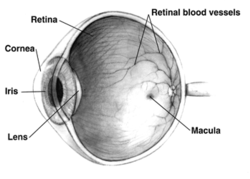Retina
The retina is the thin neural tissue that contains light sensitive neurons called photoreceptors (rods and cones) that interact with secondary and tertiary neurons inside the eyeball in humans and in many animals. Its role is to sense the light which gets into the eye and send information about it to the brain.
Most information about light images that leaves the retina travels through the optic nerve, and is used by the brain to create visual sensations. Information about light which travels through the retino-hypothamalic tract is for adjusting circadian rhythms to the 24-hour day.
The center of the human retina, called the fovea centralis, or just fovea, has the most [cone cells] for sensing bright colors and fine detail of a viewed object. Even though the fovea takes up only 1.5 square millimeters, it plays the most important role in vision. It is only around 1% of the human retina, but the fovea sends about as much information to the visual cortex as the rest of the retina combined. [1]
Additional images
Retina Media
Fundus photograph showing the blood vessels in a normal human retina. Veins are darker and slightly wider than corresponding arteries. The optic disc is at right, and the macula lutea is near the centre.
References
- ↑ Kolb, Helga; Nelson, Ralph; Fernandez, Eduardo; Jones, Bryan. webvision.med.utah.edu. e-book Moran Eye Center, University of Uta. pp. The Architecture of the Human Fovea.









